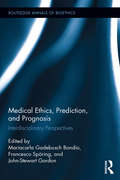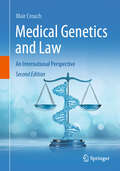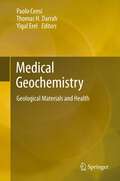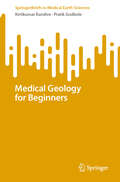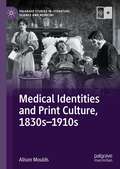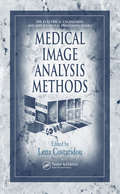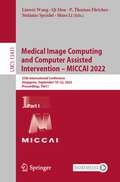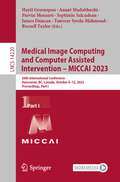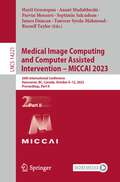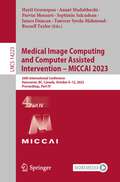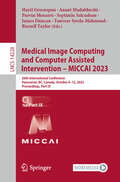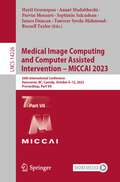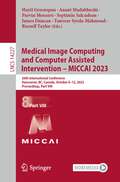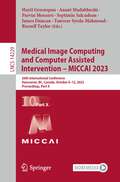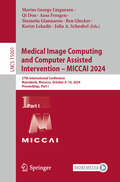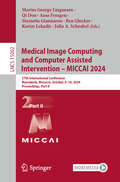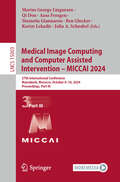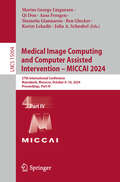- Table View
- List View
Medical Ethics, Prediction, and Prognosis: Interdisciplinary Perspectives (Routledge Annals of Bioethics)
by John-Stewart Gordon Mariacarla Gadebusch Bondio Francesco SporingRecent scientific developments, in particular advances in pharmacogenetics and molecular genetics, have given rise to numerous predictive procedures for detecting predispositions to diseases in patients. This knowledge, however, does not necessarily promise benign results for either patients or health care professionals. The aim of this volume is to analyse issues related to prediction and prognosis as a burgeoning field of medicine, which is revolutionizing the way we understand and approach diagnosis and treatment. Combining epistemic and ethical reflection with medical expertise on contemporary practice and research, an interdisciplinary group of international experts critically examine anticipatory medicine from various perspectives, including history of medicine, bioethics, theories of science, and health economics. The highly complex issues involved in medical prediction call for a far-reaching debate on the value and scope of foreknowledge. For example, which responsibilities and burdens arise when still healthy people learn of their predisposition to diseases? How should health care insurance reflect risky life styles? Is the increasing medicalization of life connected with prevention ethically sustainable and financially possible in the developing world? These and other related issues are the subject of this timely and important book, which not only serves as an introduction to the area, but also proposes many feasible solutions to the problems outlined.
Medical Gases
by Hartwig MüllerCovering the entire spectrum of medical gases, this ready reference offers a comprehensive overview of production, medical gas equipment, medical gas verification, and medical gas safety standards. With a clear focus throughout on safety, the text recommends environmentally responsible manufacturing practices during each step of the process: manufacture, storage, transport, distribution, and in applications. It also discusses standards and regulations, in particular those of the European Union. An essential guide for researchers and professionals whose work includes the manufacture, handling, or use of medical gases.
Medical Genetics and Law: An International Perspective
by Mair CrouchThis book is an essential resource to understanding the intersection of medical genetics and law. In a unique approach, it provides an overview on the biological principles of DNA basics and genetic inheritance linking the knowledge with the ethical and legal challenges presented by modern developments in genetics. The first chapters educate the reader in key concepts such as cell division, genetic inheritance, genome study methods, genetic screening and testing across various countries. It further expands into complex issues where regulation is required, in particular: controversial aspects of genetic modifications, ethical concerns around patient confidentiality and biobanks' role in linking genetic variation to complex diseases. It includes legal cases regarding negligence claims from conception to adulthood and reflects on the impact of present and future developments in genomics on the law. Readers will gain a deeper understanding of how developments in genetics impact individuals and society, helping them navigate this rapidly evolving field. Given the interdisciplinary approach, the book is suitable for both medical and law students, practicing lawyers, medical practitioners, and genetic counselors. It is particularly beneficial for those who deal with medical negligence and need to understand the genetic aspects of such cases.
Medical Genetics for the MRCOG and Beyond
by Edward S. Tobias J. Michael ConnorThis second edition has been comprehensively updated to reflect current clinical practice and the latest technical developments, including pre-implantation genetic diagnosis, array CGH, QF-PCR, non-invasive prenatal diagnosis and next generation sequencing amongst others. The first section covers basic principles, while the second outlines the more common situations where obstetrics and gynaecology interact with medical genetics. The third section contains real-life clinical case scenarios which have been selected to represent typical problems and to highlight areas which, if mismanaged, could have serious medico-legal consequences. Together with its accompanying website (www. essentialmedgen. com), it provides an invaluable guide to the use and selection of useful online genetic resources. This book is essential reading for candidates preparing for the MRCOG postgraduate examination, and any health professionals requiring a clear understanding of medical genetics and its increasingly frequent uses in obstetrics and gynaecology, where incorrect genetic advice can have serious consequences.
Medical Geochemistry
by Paolo Censi Thomas Darrah Yigal ErelThis book includes a collection of chapters illustrating the application of geochemical methods to investigate the interactions between geological materials and fluids with humans. Examples include the incorporation and human health effects of inhaling lithogenic materials, the reactivity of biological fluids with geological materials, and the impact on nascent biomineral formation. Biomineralization is investigated in terms of mineralogy, morphology, bone chemistry, and pathological significance with a focus on the health impacts of "foreign" geological/environmental trace element incorporation. One of the contribution is devoted to particulate matter, the presence of metals and metalloids in the environment, and the possibility of using human hair as a biomarker between environmental/geological exposure and human bioincorporation. Other chapters focus on the last advances on the analytical methods and instrumentational approaches to investigating the chemistry of biological fluids and tissues.
Medical Geology for Beginners (SpringerBriefs in Medical Earth Sciences)
by Kirtikumar Randive Pratik GodboleThis book is created for a diverse audience that includes geologists and Earth scientists studying the impacts of geological processes on human health, as well as health professionals and medical researchers interested in the environmental determinants of health. It is also a good reference for the environmental scientists and public health policymakers focused on sustainable practices and health risk mitigation. Additionally, undergraduate and postgraduate students, research scholars, and academicians in geosciences, environmental health, and related interdisciplinary fields will find this book valuable for their studies and research. Industry professionals in mining, environmental monitoring, and disaster management will benefit from the health insights provided. Furthermore, individuals working in Ayurveda and traditional medicine will discover valuable information on the therapeutic uses of geological materials. This book explores relationship between geology and human health, providing vital insights for professionals in both the geosciences and health sciences. It delves into how natural processes, materials, and anthropogenic activities influence human health, highlighting the critical role of Medical Geology in modern science and public health. Finally, as Professor Robert Finkleman narrates, &“Medical Geology for Beginners provides an invaluable service to the science of medical geology and to anyone interested in this subject matter and especially to the young readers who may be inspired to pursue a career in medical geology&”.
Medical Identities and Print Culture, 1830s–1910s (Palgrave Studies in Literature, Science and Medicine)
by Alison MouldsThis book examines how the medical profession engaged with print and literary culture to shape its identities between the 1830s and 1910s in Britain and its empire. Moving away from a focus on medical education and professional appointments, the book reorients attention to how medical self-fashioning interacted with other axes of identity, including age, gender, race, and the spaces of practice. Drawing on medical journals and fiction, as well as professional advice guides and popular periodicals, this volume considers how images of medical practice and professionalism were formed in the cultural and medical imagination. Alison Moulds uncovers how medical professionals were involved in textual production and consumption as editors, contributors, correspondents, readers, authors, and reviewers. Ultimately, this book opens up new perspectives on the relationship between literature and medicine, revealing how the profession engaged with a range of textual practices to build communities, air grievances, and augment its cultural authority and status in public life.
Medical Illustration in the Courtroom: Proving Injury, Causation, and Damages
by Lindsay E. CoulterMedical Illustration in the Courtroom: Proving Injury, Causation, and Damages educates the reader on how to communicate science visually—in personal injury, medical malpractice, criminal, and forensic cases—by creating art that utilizes medical records, radiographs, and computer software. Medical illustration bridges the gap between complex technical, medical, and scientific concepts to clearly illustrate, and explain visually, a medical condition, negligence, or the causation of an injury or death to the lay person. Medical artists are frequently challenged with illustrating injuries and medical conditions that can’t be seen by the naked eye. And while using medical photography and imaging for illustrative purposes can be helpful, to an untrained eye it can often be unclear or confusing. This is where the medical illustrator enters the equation. There are often patients who have recovered from an injury or infection that appear in good health. However, should an unforeseen injury or fatality happen, medical illustrators can reveal to people what’s actually going on inside the person, an invaluable asset to attorneys in the courtroom—especially for personal injury and medical malpractice cases. While many attorneys utilize medical artists, nonvisual people don’t always recognize the value of demonstrative aids until they see them first-hand.When attorneys and their clients enlist the aid of medical artists, it quickly becomes apparent that properly conceived and executed artwork is invaluable to illustrating the facts—and medical impacts—of any number of scenarios: homicides by shooting, stabbings, vehicular accidents, in addition to medical malpractice and personal injuries resulting from surgery or possible negligence.Presenting a myriad of services and computer technologies that can be utilized, Medical Illustration in the Courtroom provides demonstrative aids used in cases to illustrate personal injury and medical malpractice, employing "tricks of the trade" to create an accurate effective image. Such images are educational to attorneys, insurance adjusters, judges, and juries to help create a visual storyline, the goal being to help combine art and science to provide a clear illustration of events to help in adjudicate legal and forensic cases.
Medical Image Analysis Methods (Electrical Engineering And Applied Signal Processing Ser.)
by Lena CostaridouTo successfully detect and diagnose disease, it is vital for medical diagnosticians to properly apply the latest medical imaging technologies. It is a worrisome reality that due to either the nature or volume of some of the images provided, early or obscured signs of disease can go undetected or be misdiagnosed. To combat these inaccuracies, diagno
Medical Image Analysis and Informatics: Computer-Aided Diagnosis and Therapy
by Rangaraj M. Rangayyan Paulo Mazzoncini de Azevedo-Marques Arianna Mencattini Marcello SalmeriWith the development of rapidly increasing medical imaging modalities and their applications, the need for computers and computing in image generation, processing, visualization, archival, transmission, modeling, and analysis has grown substantially. Computers are being integrated into almost every medical imaging system. Medical Image Analysis and Informatics demonstrates how quantitative analysis becomes possible by the application of computational procedures to medical images. Furthermore, it shows how quantitative and objective analysis facilitated by medical image informatics, CBIR, and CAD could lead to improved diagnosis by physicians. Whereas CAD has become a part of the clinical workflow in the detection of breast cancer with mammograms, it is not yet established in other applications. CBIR is an alternative and complementary approach for image retrieval based on measures derived from images, which could also facilitate CAD. This book shows how digital image processing techniques can assist in quantitative analysis of medical images, how pattern recognition and classification techniques can facilitate CAD, and how CAD systems can assist in achieving efficient diagnosis, in designing optimal treatment protocols, in analyzing the effects of or response to treatment, and in clinical management of various conditions. The book affirms that medical imaging, medical image analysis, medical image informatics, CBIR, and CAD are proven as well as essential techniques for health care.
Medical Image Computing and Computer Assisted Intervention – MICCAI 2022: 25th International Conference, Singapore, September 18–22, 2022, Proceedings, Part I (Lecture Notes in Computer Science #13431)
by Shuo Li Stefanie Speidel Qi Dou Linwei Wang P. Thomas FletcherThe eight-volume set LNCS 13431, 13432, 13433, 13434, 13435, 13436, 13437, and 13438 constitutes the refereed proceedings of the 25th International Conference on Medical Image Computing and Computer-Assisted Intervention, MICCAI 2022, which was held in Singapore in September 2022. The 574 revised full papers presented were carefully reviewed and selected from 1831 submissions in a double-blind review process. The papers are organized in the following topical sections: Part I: Brain development and atlases; DWI and tractography; functional brain networks; neuroimaging; heart and lung imaging; dermatology; Part II: Computational (integrative) pathology; computational anatomy and physiology; ophthalmology; fetal imaging; Part III: Breast imaging; colonoscopy; computer aided diagnosis; Part IV: Microscopic image analysis; positron emission tomography; ultrasound imaging; video data analysis; image segmentation I; Part V: Image segmentation II; integration of imaging with non-imaging biomarkers; Part VI: Image registration; image reconstruction; Part VII: Image-Guided interventions and surgery; outcome and disease prediction; surgical data science; surgical planning and simulation; machine learning – domain adaptation and generalization; Part VIII: Machine learning – weakly-supervised learning; machine learning – model interpretation; machine learning – uncertainty; machine learning theory and methodologies.
Medical Image Computing and Computer Assisted Intervention – MICCAI 2023: 26th International Conference, Vancouver, BC, Canada, October 8–12, 2023, Proceedings, Part I (Lecture Notes in Computer Science #14220)
by James Duncan Tanveer Syeda-Mahmood Hayit Greenspan Anant Madabhushi Russell Taylor Parvin Mousavi Septimiu SalcudeanThe ten-volume set LNCS 14220, 14221, 14222, 14223, 14224, 14225, 14226, 14227, 14228, and 14229 constitutes the refereed proceedings of the 26th International Conference on Medical Image Computing and Computer-Assisted Intervention, MICCAI 2023, which was held in Vancouver, Canada, in October 2023.The 730 revised full papers presented were carefully reviewed and selected from a total of 2250 submissions. The papers are organized in the following topical sections: Part I: Machine learning with limited supervision and machine learning – transfer learning; Part II: Machine learning – learning strategies; machine learning – explainability, bias, and uncertainty; Part III: Machine learning – explainability, bias and uncertainty; image segmentation; Part IV: Image segmentation; Part V: Computer-aided diagnosis; Part VI: Computer-aided diagnosis; computational pathology; Part VII: Clinical applications – abdomen; clinical applications – breast; clinical applications – cardiac; clinical applications – dermatology; clinical applications – fetal imaging; clinical applications – lung; clinical applications – musculoskeletal; clinical applications – oncology; clinical applications – ophthalmology; clinical applications – vascular; Part VIII: Clinical applications – neuroimaging; microscopy; Part IX: Image-guided intervention, surgical planning, and data science; Part X: Image reconstruction and image registration.
Medical Image Computing and Computer Assisted Intervention – MICCAI 2023: 26th International Conference, Vancouver, BC, Canada, October 8–12, 2023, Proceedings, Part II (Lecture Notes in Computer Science #14221)
by James Duncan Tanveer Syeda-Mahmood Hayit Greenspan Anant Madabhushi Russell Taylor Parvin Mousavi Septimiu SalcudeanThe ten-volume set LNCS 14220, 14221, 14222, 14223, 14224, 14225, 14226, 14227, 14228, and 14229 constitutes the refereed proceedings of the 26th International Conference on Medical Image Computing and Computer-Assisted Intervention, MICCAI 2023, which was held in Vancouver, Canada, in October 2023.The 730 revised full papers presented were carefully reviewed and selected from a total of 2250 submissions. The papers are organized in the following topical sections: Part I: Machine learning with limited supervision and machine learning – transfer learning; Part II: Machine learning – learning strategies; machine learning – explainability, bias, and uncertainty; Part III: Machine learning – explainability, bias and uncertainty; image segmentation; Part IV: Image segmentation; Part V: Computer-aided diagnosis; Part VI: Computer-aided diagnosis; computational pathology; Part VII: Clinical applications – abdomen; clinical applications – breast; clinical applications – cardiac; clinical applications – dermatology; clinical applications – fetal imaging; clinical applications – lung; clinical applications – musculoskeletal; clinical applications – oncology; clinical applications – ophthalmology; clinical applications – vascular; Part VIII: Clinical applications – neuroimaging; microscopy; Part IX: Image-guided intervention, surgical planning, and data science; Part X: Image reconstruction and image registration.
Medical Image Computing and Computer Assisted Intervention – MICCAI 2023: 26th International Conference, Vancouver, BC, Canada, October 8–12, 2023, Proceedings, Part III (Lecture Notes in Computer Science #14222)
by James Duncan Tanveer Syeda-Mahmood Hayit Greenspan Anant Madabhushi Russell Taylor Parvin Mousavi Septimiu SalcudeanThe ten-volume set LNCS 14220, 14221, 14222, 14223, 14224, 14225, 14226, 14227, 14228, and 14229 constitutes the refereed proceedings of the 26th International Conference on Medical Image Computing and Computer-Assisted Intervention, MICCAI 2023, which was held in Vancouver, Canada, in October 2023.The 730 revised full papers presented were carefully reviewed and selected from a total of 2250 submissions. The papers are organized in the following topical sections: Part I: Machine learning with limited supervision and machine learning – transfer learning; Part II: Machine learning – learning strategies; machine learning – explainability, bias, and uncertainty; Part III: Machine learning – explainability, bias and uncertainty; image segmentation; Part IV: Image segmentation; Part V: Computer-aided diagnosis; Part VI: Computer-aided diagnosis; computational pathology; Part VII: Clinical applications – abdomen; clinical applications – breast; clinical applications – cardiac; clinical applications – dermatology; clinical applications – fetal imaging; clinical applications – lung; clinical applications – musculoskeletal; clinical applications – oncology; clinical applications – ophthalmology; clinical applications – vascular; Part VIII: Clinical applications – neuroimaging; microscopy; Part IX: Image-guided intervention, surgical planning, and data science; Part X: Image reconstruction and image registration.
Medical Image Computing and Computer Assisted Intervention – MICCAI 2023: 26th International Conference, Vancouver, BC, Canada, October 8–12, 2023, Proceedings, Part IV (Lecture Notes in Computer Science #14223)
by James Duncan Tanveer Syeda-Mahmood Hayit Greenspan Anant Madabhushi Russell Taylor Parvin Mousavi Septimiu SalcudeanThe ten-volume set LNCS 14220, 14221, 14222, 14223, 14224, 14225, 14226, 14227, 14228, and 14229 constitutes the refereed proceedings of the 26th International Conference on Medical Image Computing and Computer-Assisted Intervention, MICCAI 2023, which was held in Vancouver, Canada, in October 2023.The 730 revised full papers presented were carefully reviewed and selected from a total of 2250 submissions. The papers are organized in the following topical sections: Part I: Machine learning with limited supervision and machine learning – transfer learning; Part II: Machine learning – learning strategies; machine learning – explainability, bias, and uncertainty; Part III: Machine learning – explainability, bias and uncertainty; image segmentation; Part IV: Image segmentation; Part V: Computer-aided diagnosis; Part VI: Computer-aided diagnosis; computational pathology; Part VII: Clinical applications – abdomen; clinical applications – breast; clinical applications – cardiac; clinical applications – dermatology; clinical applications – fetal imaging; clinical applications – lung; clinical applications – musculoskeletal; clinical applications – oncology; clinical applications – ophthalmology; clinical applications – vascular; Part VIII: Clinical applications – neuroimaging; microscopy; Part IX: Image-guided intervention, surgical planning, and data science; Part X: Image reconstruction and image registration.
Medical Image Computing and Computer Assisted Intervention – MICCAI 2023: 26th International Conference, Vancouver, BC, Canada, October 8–12, 2023, Proceedings, Part IX (Lecture Notes in Computer Science #14228)
by James Duncan Tanveer Syeda-Mahmood Hayit Greenspan Anant Madabhushi Russell Taylor Parvin Mousavi Septimiu SalcudeanThe ten-volume set LNCS 14220, 14221, 14222, 14223, 14224, 14225, 14226, 14227, 14228, and 14229 constitutes the refereed proceedings of the 26th International Conference on Medical Image Computing and Computer-Assisted Intervention, MICCAI 2023, which was held in Vancouver, Canada, in October 2023. The 730 revised full papers presented were carefully reviewed and selected from a total of 2250 submissions. The papers are organized in the following topical sections: Part I: Machine learning with limited supervision and machine learning – transfer learning; Part II: Machine learning – learning strategies; machine learning – explainability, bias, and uncertainty; Part III: Machine learning – explainability, bias and uncertainty; image segmentation; Part IV: Image segmentation; Part V: Computer-aided diagnosis; Part VI: Computer-aided diagnosis; computational pathology; Part VII: Clinical applications – abdomen; clinical applications – breast; clinical applications – cardiac; clinical applications – dermatology; clinical applications – fetal imaging; clinical applications – lung; clinical applications – musculoskeletal; clinical applications – oncology; clinical applications – ophthalmology; clinical applications – vascular; Part VIII: Clinical applications – neuroimaging; microscopy; Part IX: Image-guided intervention, surgical planning, and data science; Part X: Image reconstruction and image registration.
Medical Image Computing and Computer Assisted Intervention – MICCAI 2023: 26th International Conference, Vancouver, BC, Canada, October 8–12, 2023, Proceedings, Part V (Lecture Notes in Computer Science #14224)
by James Duncan Tanveer Syeda-Mahmood Hayit Greenspan Anant Madabhushi Russell Taylor Parvin Mousavi Septimiu SalcudeanThe ten-volume set LNCS 14220, 14221, 14222, 14223, 14224, 14225, 14226, 14227, 14228, and 14229 constitutes the refereed proceedings of the 26th International Conference on Medical Image Computing and Computer-Assisted Intervention, MICCAI 2023, which was held in Vancouver, Canada, in October 2023. The 730 revised full papers presented were carefully reviewed and selected from a total of 2250 submissions. The papers are organized in the following topical sections: Part I: Machine learning with limited supervision and machine learning – transfer learning; Part II: Machine learning – learning strategies; machine learning – explainability, bias, and uncertainty; Part III: Machine learning – explainability, bias and uncertainty; image segmentation; Part IV: Image segmentation; Part V: Computer-aided diagnosis; Part VI: Computer-aided diagnosis; computational pathology; Part VII: Clinical applications – abdomen; clinical applications – breast; clinical applications – cardiac; clinical applications – dermatology; clinical applications – fetal imaging; clinical applications – lung; clinical applications – musculoskeletal; clinical applications – oncology; clinical applications – ophthalmology; clinical applications – vascular; Part VIII: Clinical applications – neuroimaging; microscopy; Part IX: Image-guided intervention, surgical planning, and data science; Part X: Image reconstruction and image registration.
Medical Image Computing and Computer Assisted Intervention – MICCAI 2023: 26th International Conference, Vancouver, BC, Canada, October 8–12, 2023, Proceedings, Part VI (Lecture Notes in Computer Science #14225)
by James Duncan Tanveer Syeda-Mahmood Hayit Greenspan Anant Madabhushi Russell Taylor Parvin Mousavi Septimiu SalcudeanThe ten-volume set LNCS 14220, 14221, 14222, 14223, 14224, 14225, 14226, 14227, 14228, and 14229 constitutes the refereed proceedings of the 26th International Conference on Medical Image Computing and Computer-Assisted Intervention, MICCAI 2023, which was held in Vancouver, Canada, in October 2023. The 730 revised full papers presented were carefully reviewed and selected from a total of 2250 submissions. The papers are organized in the following topical sections: Part I: Machine learning with limited supervision and machine learning – transfer learning; Part II: Machine learning – learning strategies; machine learning – explainability, bias, and uncertainty; Part III: Machine learning – explainability, bias and uncertainty; image segmentation; Part IV: Image segmentation; Part V: Computer-aided diagnosis; Part VI: Computer-aided diagnosis; computational pathology; Part VII: Clinical applications – abdomen; clinical applications – breast; clinical applications – cardiac; clinical applications – dermatology; clinical applications – fetal imaging; clinical applications – lung; clinical applications – musculoskeletal; clinical applications – oncology; clinical applications – ophthalmology; clinical applications – vascular; Part VIII: Clinical applications – neuroimaging; microscopy; Part IX: Image-guided intervention, surgical planning, and data science; Part X: Image reconstruction and image registration.
Medical Image Computing and Computer Assisted Intervention – MICCAI 2023: 26th International Conference, Vancouver, BC, Canada, October 8–12, 2023, Proceedings, Part VII (Lecture Notes in Computer Science #14226)
by James Duncan Tanveer Syeda-Mahmood Hayit Greenspan Anant Madabhushi Russell Taylor Parvin Mousavi Septimiu SalcudeanThe ten-volume set LNCS 14220, 14221, 14222, 14223, 14224, 14225, 14226, 14227, 14228, and 14229 constitutes the refereed proceedings of the 26th International Conference on Medical Image Computing and Computer-Assisted Intervention, MICCAI 2023, which was held in Vancouver, Canada, in October 2023. The 730 revised full papers presented were carefully reviewed and selected from a total of 2250 submissions. The papers are organized in the following topical sections: Part I: Machine learning with limited supervision and machine learning – transfer learning; Part II: Machine learning – learning strategies; machine learning – explainability, bias, and uncertainty; Part III: Machine learning – explainability, bias and uncertainty; image segmentation; Part IV: Image segmentation; Part V: Computer-aided diagnosis; Part VI: Computer-aided diagnosis; computational pathology; Part VII: Clinical applications – abdomen; clinical applications – breast; clinical applications – cardiac; clinical applications – dermatology; clinical applications – fetal imaging; clinical applications – lung; clinical applications – musculoskeletal; clinical applications – oncology; clinical applications – ophthalmology; clinical applications – vascular; Part VIII: Clinical applications – neuroimaging; microscopy; Part IX: Image-guided intervention, surgical planning, and data science; Part X: Image reconstruction and image registration.
Medical Image Computing and Computer Assisted Intervention – MICCAI 2023: 26th International Conference, Vancouver, BC, Canada, October 8–12, 2023, Proceedings, Part VIII (Lecture Notes in Computer Science #14227)
by James Duncan Tanveer Syeda-Mahmood Hayit Greenspan Anant Madabhushi Russell Taylor Parvin Mousavi Septimiu SalcudeanThe ten-volume set LNCS 14220, 14221, 14222, 14223, 14224, 14225, 14226, 14227, 14228, and 14229 constitutes the refereed proceedings of the 26th International Conference on Medical Image Computing and Computer-Assisted Intervention, MICCAI 2023, which was held in Vancouver, Canada, in October 2023. The 730 revised full papers presented were carefully reviewed and selected from a total of 2250 submissions. The papers are organized in the following topical sections: Part I: Machine learning with limited supervision and machine learning – transfer learning; Part II: Machine learning – learning strategies; machine learning – explainability, bias, and uncertainty; Part III: Machine learning – explainability, bias and uncertainty; image segmentation; Part IV: Image segmentation; Part V: Computer-aided diagnosis; Part VI: Computer-aided diagnosis; computational pathology; Part VII: Clinical applications – abdomen; clinical applications – breast; clinical applications – cardiac; clinical applications – dermatology; clinical applications – fetal imaging; clinical applications – lung; clinical applications – musculoskeletal; clinical applications – oncology; clinical applications – ophthalmology; clinical applications – vascular; Part VIII: Clinical applications – neuroimaging; microscopy; Part IX: Image-guided intervention, surgical planning, and data science; Part X: Image reconstruction and image registration.
Medical Image Computing and Computer Assisted Intervention – MICCAI 2023: 26th International Conference, Vancouver, BC, Canada, October 8–12, 2023, Proceedings, Part X (Lecture Notes in Computer Science #14229)
by James Duncan Tanveer Syeda-Mahmood Hayit Greenspan Anant Madabhushi Russell Taylor Parvin Mousavi Septimiu SalcudeanThe ten-volume set LNCS 14220, 14221, 14222, 14223, 14224, 14225, 14226, 14227, 14228, and 14229 constitutes the refereed proceedings of the 26th International Conference on Medical Image Computing and Computer-Assisted Intervention, MICCAI 2023, which was held in Vancouver, Canada, in October 2023. The 730 revised full papers presented were carefully reviewed and selected from a total of 2250 submissions. The papers are organized in the following topical sections: Part I: Machine learning with limited supervision and machine learning – transfer learning; Part II: Machine learning – learning strategies; machine learning – explainability, bias, and uncertainty; Part III: Machine learning – explainability, bias and uncertainty; image segmentation; Part IV: Image segmentation; Part V: Computer-aided diagnosis; Part VI: Computer-aided diagnosis; computational pathology; Part VII: Clinical applications – abdomen; clinical applications – breast; clinical applications – cardiac; clinical applications – dermatology; clinical applications – fetal imaging; clinical applications – lung; clinical applications – musculoskeletal; clinical applications – oncology; clinical applications – ophthalmology; clinical applications – vascular; Part VIII: Clinical applications – neuroimaging; microscopy; Part IX: Image-guided intervention, surgical planning, and data science; Part X: Image reconstruction and image registration.
Medical Image Computing and Computer Assisted Intervention – MICCAI 2024: 27th International Conference, Marrakesh, Morocco, October 6–10, 2024, Proceedings, Part I (Lecture Notes in Computer Science #15001)
by Marius George Linguraru Aasa Feragen Ben Glocker Julia A. Schnabel Karim Lekadir Qi Dou Stamatia GiannarouThe 12-volume set LNCS 15001 - 15012 constitutes the proceedings of the 27th International Conferenc on Medical Image Computing and Computer Assisted Intervention, MICCAI 2024, which took place in Marrakesh, Morocco, during October 6–10, 2024. MICCAI accepted 857 full papers from 2781 submissions. They focus on neuroimaging; image registration; computational pathology; computer aided diagnosis, treatment response, and outcome prediction; image guided intervention; visualization; surgical planning, and surgical data science; image reconstruction; image segmentation; machine learning; etc.
Medical Image Computing and Computer Assisted Intervention – MICCAI 2024: 27th International Conference, Marrakesh, Morocco, October 6–10, 2024, Proceedings, Part II (Lecture Notes in Computer Science #15002)
by Marius George Linguraru Aasa Feragen Ben Glocker Julia A. Schnabel Karim Lekadir Qi Dou Stamatia GiannarouThe 12-volume set LNCS 15001 - 15012 constitutes the proceedings of the 27th International Conferenc on Medical Image Computing and Computer Assisted Intervention, MICCAI 2024, which took place in Marrakesh, Morocco, during October 6–10, 2024. MICCAI accepted 857 full papers from 2781 submissions. They focus on neuroimaging; image registration; computational pathology; computer aided diagnosis, treatment response, and outcome prediction; image guided intervention; visualization; surgical planning, and surgical data science; image reconstruction; image segmentation; machine learning; etc.
Medical Image Computing and Computer Assisted Intervention – MICCAI 2024: 27th International Conference, Marrakesh, Morocco, October 6–10, 2024, Proceedings, Part III (Lecture Notes in Computer Science #15003)
by Marius George Linguraru Aasa Feragen Ben Glocker Julia A. Schnabel Karim Lekadir Qi Dou Stamatia GiannarouThe 12-volume set LNCS 15001 - 15012 constitutes the proceedings of the 27th International Conferenc on Medical Image Computing and Computer Assisted Intervention, MICCAI 2024, which took place in Marrakesh, Morocco, during October 6–10, 2024. MICCAI accepted 857 full papers from 2781 submissions. They focus on neuroimaging; image registration; computational pathology; computer aided diagnosis, treatment response, and outcome prediction; image guided intervention; visualization; surgical planning, and surgical data science; image reconstruction; image segmentation; machine learning; etc.
Medical Image Computing and Computer Assisted Intervention – MICCAI 2024: 27th International Conference, Marrakesh, Morocco, October 6–10, 2024, Proceedings, Part IV (Lecture Notes in Computer Science #15004)
by Marius George Linguraru Aasa Feragen Ben Glocker Julia A. Schnabel Karim Lekadir Qi Dou Stamatia GiannarouThe 12-volume set LNCS 15001 - 15012 constitutes the proceedings of the 27th International Conferenc on Medical Image Computing and Computer Assisted Intervention, MICCAI 2024, which took place in Marrakesh, Morocco, during October 6–10, 2024. MICCAI accepted 857 full papers from 2781 submissions. They focus on neuroimaging; image registration; computational pathology; computer aided diagnosis, treatment response, and outcome prediction; image guided intervention; visualization; surgical planning, and surgical data science; image reconstruction; image segmentation; machine learning; etc.
